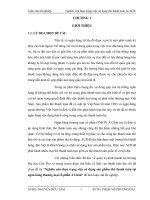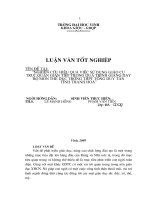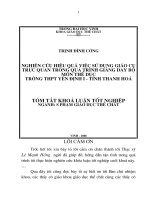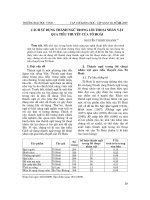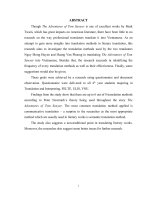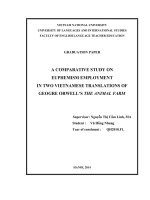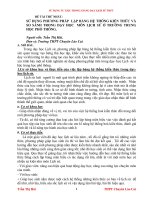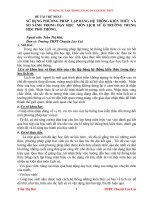NGHIÊN CỨU SO SÁNH VIỆC SỬ DỤNG UYỂN NGỮ TRONG HAI BẢN DỊCH TIẾNG VIỆT CỦA TÁC PHẨM THE ANIMAL FARM (GEORGE ORWELL)
Bạn đang xem bản rút gọn của tài liệu. Xem và tải ngay bản đầy đủ của tài liệu tại đây (278.3 KB, 52 trang )
VIETNAM NATIONAL UNIVERSITY
UNIVERSITY OF LANGUAGES AND INTERNATIONAL STUDIES
FACULTY OF ENGLISH LANGUAGE TEACHER EDUCATION
GRADUATION PAPER
A COMPARATIVE STUDY ON
EUPHEMISM EMPLOYMENT
IN TWO VIETNAMESE TRANSLATIONS OF
GEOGRE ORWELL’S THE ANIMAL FARM
Supervisor: Nguyễn Thị Cẩm Linh, MA
Student : Vũ Hồng Nhung
Year of enrolment : QH2010.F1.
HANOI, 2014
ĐẠI HỌC QUỐC GIA HÀ NỘI
TRƯỜNG ĐẠI HỌC NGOẠI NGỮ
KHOA SƯ PHẠM TIẾNG ANH
KHÓA LUẬN TỐT NGHIỆP
NGHIÊN CỨU SO SÁNH VIỆC SỬ DỤNG UYỂN NGỮ
TRONG HAI BẢN DỊCH TIẾNG VIỆT CỦA TÁC
PHẨM THE ANIMAL FARM (GEORGE ORWELL)
Giáo viên hướng dẫn: ThS. Nguyễn Thị Cẩm Linh
Sinh viên : Vũ Hồng Nhung
Khóa: QH2010.F1.
HÀ NỘI, 2014
DECLARATION
I hereby state that I, Vũ Hồng Nhung, QH2010.F1.E21, being a candidate for the
degree of Bachelor of Arts (TEFL) accept the requirements of the College relating to
the retention and use of Bachelor’s Graduation Paper deposited in the library.
In terms of these conditions, I agree that the origin of my paper deposited in the
library should be accessible for the purposes of study and research, in accordance
with the normal conditions established by the librarian for the care, loan or
reproduction of the paper.
Hanoi, 2014
Vũ Hồng Nhung
i
ACKNOWLEDGEMENTS
First and foremost, I would like to express my sincere gratitude to my
supervisor, Ms. Nguyễn Thị Cẩm Linh, MA for her precious guidance, valuable advice
as well as her encouragement which were the decisive factors motivating me in
accomplishing the paper despite the geographical distance between us.
Second, I would like to express my special thank to Ms. Ngô Hà Thu for her
inspiring talks which turned out to be my motivation that not only helped finish my
graduation paper but broadened my background knowledge as well.
In addition, I would love to express my high appreciation for the special
encouragement from my former English teacher, Ms. Phạm Thu Hương, who plays an
important role in giving useful pieces of advice that helped keep my mind in balance
despite the hardship I was suffering from.
Besides, I also feel grateful for my family, especially my younger brother, for
the strong support and special caring and treatment since the very first moment of my
doing this graduation paper till the very last one.
Finally, I would like to say thank you to all of my friends whose helpful
comments and wholehearted encouragement constructively contribute to the paper
proceeding.
ii
i
ABSTRACT
Generally, euphemism employment in translation gets hold of an
essential importance in not only orienting the audience’s attitude towards the
characters mentioned in the plot but also mitigating the intension (if any)
resulted in by the cultural conflict(s) between the source language and the target
language. However, there are no abundant resources for studies on this research
topic at present; therefore, the researcher was inspired to conduct a comparative
study on euphemism in two Vietnamese translations of George Orwell’s The
Animal Farm, which are translations produced by Phạm Minh Ngọc and An Lý.
Accordingly, a two-fold objective is addressed, particularly to figure out how
different and/or similar the translations are and what approaches taken by two
translations to employ euphemism. Thanks to the methodology presented in
Chapter 3, the researcher finds out that both of translators did employ
euphemistic expressions though the frequency of euphemism employment in
An’s translation is greater than that in Phạm’s. In addition, two main
approaches taken to employ euphemism are also called out which are
grammatical and lexical modalities. Hopefully, this paper’s findings and
suggestions could partly contribute to enriching the data source on euphemism
employment in translation for further studies.
iii
ii
TABLE OF CONTENTS
Acknowledgments i
Abstract ii
Table of contents iii
List of abbreviations v
List of tables and figures vi
Chapter 1- Introduction 1
1.1. Statement of the problem and rationale 1
1.2.Aims and objectives 2
1.3.Scope of the study 3
1.4.Significance of the study 3
1.5.Organization of the study 3
Chapter 2 – Literature review 5
2.1.Translation 5
2.1.1.Definitions of translation 5
2.1.2.Methods of translation 6
2.1.3.Communicative translation and semantic translation 9
2.2.Equivalence in translation 10
2.2.1.Language and culture 10
2.2.2.Definitions of equivalence in translation 11
2.2.3.Types of equivalence 12
2.3.Euphemism 13
2.3.1.Definitions of euphemism 13
2.3.2.Classification of euphemism 14
2.3.3.Theory of euphemism in translation 15
Chapter 3 - Methodology 17
3.1.Research approaches 17
iv
iii
3.2.Participants 17
3.3.Data collection instrument and procedure 18
Chapter 4 - Findings and interpretation 20
4.1.Research question 1: A comparison of euphemism employment between
two translations 20
4.2.Research question 2: Approaches of euphemism employment in two
translations 26
4.2.1.Lexical modality 26
4.2.3.Grammatical modality 31
Chapter 5- Conclusion 34
5.1.Summary 34
5.2.Limitations of the study 35
5.3.Suggestions for further studies 36
References 38
Appendix 40
v
iv
LIST OF ABBREVIATIONS
- FELTE: Faculty of English Language Teacher Education
- ULIS: University of Languages and International Studies
- VNU: Vietnam National University
- SL: Source language
- TL: Target language
vi
v
LIST OF TABLES AND FIGURES
- List of tables
No. Table Page
1
Table 4.1: A demonstration of how source words/ phrases
are translated into Vietnamese by two translators
20
2
Table 4.2.1.a: A demonstration of lexical modality-based
euphemism employment in the two translations.
27
3
Table 4.2.1.b: A demonstration of phrase in replace of
word/ phrase modality presented in the two translations
28
4 Table 4.2.1.c: A demonstration of Sino-Vietnamese
involvement in the two translations
29
- List of figures
No. Figure Page
1
Figure 4.2.1.1: How lexical modality applied in Phạm’s
translation
30
2
Figure 4.2.1.1: How lexical modality applied in An’s
translation.
30
vii
vi
vi
CHAPTER 1: INTRODUCTION
1.1. Statement of the problem and rationale for the study
In Vietnam’s literature world, it can be noted that there are two major groups of
audience who approach foreign literary works. The former group often includes people
with proficiency high enough to master the source language. Not only are they able to
read the work but they can figure out the message behind the lines and the attitude of
the author as well. People in the latter group are those who employ the translation of
the work to enjoy its humanism. However, the size of the latter group probably
overwhelms the former one. As the statistic number from some big Vietnamese
publishing houses revealed in Vietnam’s book market, the number of translated copies
is as many times as the available original ones. For instance, according to Trẻ
Publishing House’s copyright deposit data, there were 25,000 Vietnamese translation
copies of The Diary of a Young Girl by Anne Frank, which has been praised through
decades, sold in 1987 whilst there were not many original ones available at that time.
Thence, translation has been an essential language-transferring means which helps
spread out the foreign literature in the domestic sphere.
As a matter of fact, a variety of translation procedures coupled with methods are
made full use of on the platform of translation theory so as to produce a high quality
translation. Obviously, there exists cultural differences between languages; therefore,
in addition to transferring the explicit content of the literary work, a translator is
expected to utilize proper representation language to denote a certain matter. For
example, a political issue mentioned in a source text, which is considered neutral in the
source culture, might be offensive or extremely sensitive in the target culture. Or in
other case, the target language is selected carefully to ease the intensive atmosphere in
literature. Hence, the translator needs be aware of and pay best attention to the
language expression, particularly lexical choice, in order that the key message is still
1
well-conveyed while the severe tone is regulated. In a nutshell, that modus of
translation is likely to involve euphemism in translation.
In spite of the vital role of euphemism in translation that partly orients
audience’s emotion to some extent; the number of studies on this field is still finite.
Furthermore, up to now, there have been very few researchers in Vietnam in general
and none at the Faculty of English Language Teacher Education (FELTE), University
of Languages and International Studies (ULIS), Vietnam National University, Hanoi
(VNU) who lend insight into the popular ways of euphemism translation in literature.
The most updated research was carried by Phan Thị Thu Thủy in Đà Nẵng city two
years ago entitled An investigation into English-Vietnamese translation of euphemism.
M.A. defended in the University of Danang. Nevertheless, this study has not
pinpointed the key issue yet. It would rather calculate the rates of euphemism
employment or translation in a number of books that seem irrelevant to each other,
then give the explanation for it.
For all above-mentioned reasons and being inspired to seek something new in
translation practice, the researcher wishes to carry out a study entitled “A
comparative study on euphemism employment in two Vietnamese translations of
George Orwell’s The Animal Farm”. This study coupled with its findings is expected
to serve as a useful source of reference and assistance for those who hold an interest in
this area.
1.2. Aims and objectives
This research aims to accomplish two-fold purposes. The first purpose is to
investigate the practice of employing euphemism in the source and target texts. Then,
the researcher is expected to draw a conclusion of what are the methods that translators
applied to create euphemism and employ it in their translation after doing data
analysis.
In other words, this study will mainly focus on dealing with two questions as
below:
2
1. What are differences and/or similarities of euphemism employment in
English-Vietnamese translation as seen in examples taken from two translated
versions of George Orwell’s The Animal Farm?
2. What are the main approaches taken by the two translators in employing
euphemism in English-Vietnamese translation?
1.3. Scope of the study
This paper pays attention only to the current situation of translating English
euphemism into Vietnamese in two translated versions of George Orwell’s The Animal
Farm. To be more specific, one translation named Trại Súc Vật is done by Phạm Minh
Ngọc (Giấy Vụn publisher, 2003) and the other Vietnamese version called Chuyện ở
Nông trại is completed by An Lý (Nhã Nam culture and communication JSC, 2013).
Then, a comparison would be made so as to withdraw the similarities and differences
between those versions.
1.4. Significance of study
Although this paper was conducted on a small scale, i.e. one not to be
generalized, the researcher expects that its findings might:
a) inspire those who are interested in investigating into translating figures of
speech into Vietnamese, especially English euphemism;
b) and contribute to another research question: What suggestions can be made for
other senior students majoring in translation and interpreting to employ
euphemism in English-Vietnamese translation effectively.
1.5. Organization of the study
The paper consists of 5 chapters.
Chapter 1 provides a brief introduction to the subject and an overview of the
paper.
Chapter 2 reviews relevant literature including an overview of definitions of key
concepts (translation and euphemism) as well as some fundamental theories of
translation and euphemism translation.
Chapter 3 describes the method utilized in this study.
Chapter 4 presents and analyzes the collected data from questionnaire’s responses
and text analyses.
3
Chapter 5 summarizes some main issues mentioned in the research, offers the
limitations of the study and suggestions for further research. Following the
chapters are the references and appendices.
4
CHAPTER 2: LITERATURE REVIEW
This chapter is expected to describe and provide critical comments on previous
studies which relates to the research topic.
2.1. Translation
2.1.1. Definitions of translation
Translation has long been an essential social science owing to the
demand for mutual understanding among people speaking different languages.
Since it came into existence, there has been a wide range of definitions denoting
what translation is. Following are among the three most updated ones:
In his book of A Linguistic Theory of Translation (1965), Cartfod
considers that translation is no longer a dangerous technique once people can
apprehend its nature and control its usages. Besides, it is very translation that
operates the process of a text’s language transferring. Particularly, “translation
is the replacement of textual material in one language (SL) by equivalent
textual material in another language (TL)” (p. 25) in which the core issue of
translation is mentioned concerning the equivalence between SL and TL.
Nonetheless, it is widely accepted to be sometimes impossible to work out an
appropriate SL equivalent for a TL word. Thence, the definition is not quite
satisfactory yet.
Sharing the same point of view, Burgin (1986) demonstrates the essence
of translation that it goes beyond ameliorating a nation’s language and culture,
beyond breathing new life into the source text, beyond providing a language
with articulation, and becomes an entry way into a universal language.
In addition, expressing his agreement on the same viewpoint of the
translation’s definition with the two theorists above, Larson (1984), in her book
titled Meaning-based Translation, additionally covers other aspects of
5
translation inclusive of the analyzing process, author’s intention, readership and
rendering:
Translation is studying the lexicon, grammatical structure,
communication situation, and cultural context of the source language
text, analyzing it in order to determine its meaning, and then
reconstructing this same meaning using lexicon and grammatical
structure which are appropriate in the receptor language and its cultural
context. (Larson, 1984, pp. 3-4)
Another definition of translation introduced by Newmark (1988) is that:
“Translation is rendering the meaning of a text into another language in the way
that the author intended the text.” (p. 5) Like Catford’s given definition,
Newmark’s only considers a single aspect of translation, which is author’s
intention whilst neglects all the others.
All things considered, the researcher decided to use the definition of
translation given by Larson (1984) in this paper due to its extensive coverage of
translation study.
2.1.2. Methods of translation
In order to produce a high quality translated version of the source text, a
translator is supposed to at least partly acquire the knowledge of translation
theory. Whenever translation is mentioned, it always refers to a process
comprising the harmonic transference of language that allows the recipients to
get the point with what messages that the author is trying to convey. Thus, a
large number of researchers have spent time on the perusal of translation
methods. Below are predominant methods suggested by prestigious scholars.
First and foremost, Newmark (1988) concerns the differences between
translation methods and translations by indicating “while translation methods
relate to whole texts, translations are used for sentences and the smaller units of
language” (p.24). Then, he proposes eight methods of translation, particularly:
6
(1) Word for word translation is the process in which SL word-order is
preserved, and it barely pays attention to grammar. Words are translated
by their most common meanings and out of context.
For example:
They met many difficulties. (Orwell, 1945, p. 11)
Họ gặp nhiều khó khăn. (Phạm, 2003, p. 17)
(2) Literal translation is the process in which SL grammatical
structures are converted to their nearest equivalent in the TL, BUT
words are still translated singly and out of context.
For example:
There were more songs, more speeches, more
processions. (Orwell, 1945, p. 44)
Ca hát nhiều hơn, diễn thuyết nhiều hơn, diễu hành cũng
nhiều hơn. (An, 2013, p. 132)
(3) Faithful translation is the process in which words are translated in
context BUT uncompromising to TL. It would transfer cultural words
rather than naturalize and often read like a translation.
For example:
The farm had had a fairly successful year.
(Orwell, 1945, p. 44)
Năm ấy trại khá được mùa.(An, 2013, p. 130)
(4) Semantic translation is more flexible than faithful translation. It is
translating certain cultural words into neutral equivalents in the TL.
Better attention is paid to great focus on aesthetic features of ST (at
expense of meaning if necessary). It has close rendering of metaphors,
collocations, technical terms, slang, colloquialisms, unusual syntactic
structures and collocations, peculiarly used words, neologism, badly
written or inaccurate passages.
For example:
The boy did not stir. (Orwell, 1945, p. 17)
Gã chẳng động cựa gì hết. (An, 2013, p. 52)
(5) Communicative translation is freer than semantic translation. It
gives priority to the effectiveness of the message to be communicated
and focuses on factors such as readability and naturalness. Thus, both
7
the content and the language are readily acceptable and comprehensible
to the reader
For example:
There was much discussion as to what the battle
should be called. (Orwell, 1945, p. 17)
Chúng tranh cãi rất lâu về chuyện đặt tên cho chiến thắng.
(Phạm, 2003, p. 23)
(6) Idiomatic translation is the process reproducing the ‘message’ of
the original. It prefers colloquialisms and idioms which do not exist in
the original with the outcome as lively, ‘natural’ translation as much as
possible.
For example:
In January there came bitterly hard weather.
(Orwell, 1945, p. 18)
Ra giêng, trời trở rét cắt da cắt thịt. (An, 2013, p. 56)
(7) Free translation is to reproduce the matter without the manner; the
content without the form of the original and paraphrase much larger
than the original.
(8) Adaption is the freest form of translation and preserves the theme,
plots, characters only in which the SL culture is converted to the TL
culture. It is a kind of rewriting the text in translation.
In addition, sharing the concern on translation methods, Levý (1984), a
paramount Czech translation scholar, believes that there exists immorality if a
translator is bound to omit or contract any difficult or challenging expression
that needs translating. In his opinion, the translator is also responsible for
figuring out the solution to the most hard-to-tackle problem(s). Besides, he
propounds that the functional view must be adopted both meaning and manner.
Albeit the translator could never be the author of the SL text, he is the one who
produces its translation; therefore, he is still required to consider his
professional ethic as the way to show his respect to the TL readers.
8
In a nutshell, there is no right or wrong translation method. It is how the
translator employs the methods that matters. It is advisable that the translator
flexibly applies each method in the appropriate context to make full use of it.
2.1.3. Communicative translation and Semantic translation
Putting himself in the readers’ shoe, Newmark (1988) distinguishes
communication translation and semantic one which is illustrated as in the
following diagram:
D
Diagram 2.1.: Distinction of communicative translation and
semantic translation (Newmark, 1988, p.47)
Newmark (1988, p. 47) also entrusts that “only semantic and
communicative translation fulfill the two main aims of translation, which are
9
first, accuracy, and second, economy.” Accordingly, all of the translated
versions to some extent embrace not only semantic aspect but communicative,
social and individual ones as well.
In terms of communicative translation approach, the author insists that
only the meaning of the SL motivates the reader’s grasp of the identical
message. Following this approach, the translator is granted to do some
modification and correction to guarantee the translation’s quality within certain
limitation of TL readers’ level of knowledge and intelligence. The translator is
attempted to produce a simple and brief translation whose main message is paid
better attention. Subsequently, communicative translation’s language often
sounds natural and resourceful. In contrast, semantic translation as a whole
favours “the thought processes of the author” (p. 47) with the tendency of over-
translating and maintaining word’s shadow of meaning. It sounds more
complex and awkward. Hence, semantic translation’s product is usually
“inferior in its original - as there is both cognitive and pragmatic loss” (p. 48).
In conclusion, Newmark (1988) perhaps faces some confusion there
when he recognizes that communicative translation theoretically provides the
translator with no more freedom than semantic translation. However, he still
admits that it actually does on the platform of TL readership friendliness.
2.2. Equivalence in translation
2.2.1. Language and Culture
Spending time doing research in this field, Sapir (1956, p. 13) once
claimed that “language is a guide to social reality” and language has turned
out to be an expression medium that they utilize among their society.
Therefore, it can be understood that human would employ language to
reverberate and record their daily behaviours and communications which
eventually becomes their traditions and customs then culture. To obtain
mutual understanding, speakers from different places all around the world
10
need to acquire their partners’ language first. On that basis, they can
approach each other’s culture ultimately.
Also, Kramsch (1998) concedes in his book of Language and
Culture that language is a major means of communication by which human
exchange with each other their life information inclusive of delivering their
culture identity. As a role of a scholar, he does not deny that “words also
reflect author’s attitude and beliefs, their point of view” (p. 4). Thus, it is
very language that “expresses cultural reality” (p. 4) as people’s utterance
often involves their popular experience. They are supposed to create
experience via the language that they use.
In such a way, the researcher finds out that there exists a close-knit
relation between language and culture. Thus, a translator is compulsory to
take cultural factor into consideration when doing the job of language-
transferring.
2.2.2. Definitions of equivalence in translation
Equivalence is defined in Oxford Dictionary (2005, p. 493) as the
state of “equal in value, meaning, importance”. Hence, it can be said that in
a specific linguistic unit in one language carries the same intended meaning
or message embedded in a specific linguistic medium in another language,
then these two units are regarded as the equivalents.
Mentioning equivalents, researchers can refer to basic linguistic
elements namely morphemes, words, phrases, clauses, idioms and proverbs.
Thus, figuring out the equivalent is a quite challenging stage in translation
process. However, the translator is not expected to always find out one-to-
one equivalents. The equivalence term here shall be understood with the
comparative meaning as sometimes two different linguistic units in the two
languages perform the same function. In other words, it is the relationship
between a ST and a TT that allows the TT to be considered as a translation
11
of the ST. And, equivalence performs a relationship between two texts in
two different languages instead of the languages themselves.
2.2.3. Types of equivalence
Researchers have different criteria to classify equivalence in
translation. This paper will focus on the common groups of meaning-based
equivalence. Accordingly, Koller (1979) has categorized 5 types of
equivalence as below:
(1) Denotative equivalence: is one in which the SL and TL words
refer to the same referent in the reality. There is referential identity
between SL and TL units. Besides, it is considered the equivalence of
the extra linguistic content of a text, otherwise called content
invariance.
(2) Connotative equivalence: suggests that SL and TL words should
produce the same communicative values in the mind of native
speakers of the two languages. The connotation certainly transmitted
the selections of word (particularly where there is a specific choice
between synonymous expressions) concerning about level of style,
frequency, the social and geographical dimension, etc. It is also
known as stylistic equivalence.
(3) Text-normative equivalence: is one in which the SL and TL
words are used in the same or similar context in their respective
languages. Text – normative equivalence relates to text-type specific
features or text and language norms for given text types.
(4) Pragmatic equivalence: refers that the SL and TL words have the
same influence on the readers. Also, it is called communicative
equivalence,
12
(5) Formal equivalence: focuses on the form of the text: rhythm, verb
form, special stylistic forms of expression in syntax and lexis, word
play, metaphor… It is particularly used in translation of poems, songs,
etc. It is also called expressive equivalence.
In short, equivalence consideration is necessarily involved in the stage of
selecting words for a translation in order to get targeted expression as its
translator’s set objectives. To do so a translator is required to make the same
great efforts as in clarifying TL readership. This classification supports
translator to obtain the translation effectiveness.
2.3. Euphemism
2.3.1. Definitions of euphemism
Once cross-cultural expression is shown out, cultural translation will be
required which led the translator to be aware of both of the source and target
cultures. In order to avoid unexpected misunderstanding or cultural conflicts,
the translator asks for help of euphemism in translation. According to the
definition of euphemism introduced in Merriam-Webster Online Dictionary
(n.d.):
Euphemism is the substitution of an agreeable or inoffensive
expression for one that may offend or suggest something unpleasant;
also: the expression so substituted.
Whilst a semantic research, Leech (1981, p. 45) regards euphemism as
“the practice of referring to something offensive or delicate in terms that make
it sound more pleasant.” Eighteen years later, Sanderson (1999) raises his voice
in agreement with the idea that “euphemism can be used as a way of being
vague and unclear, or to cover up the truth or reality of a situation” (p. 259).
Simply to understand, there are certainly phrases in a society or culture
that cannot be explicitly expressed in other society or culture. Therefore,
13
euphemism appearance is bound to ease the tense that could happen in the
translation. In addition, euphemism is no longer concerned by Western
scholars; a number of Asian researchers inclusive of Vietnamese ones have
conducted studies related to euphemism usage. Particularly, Trương (2003), in
his master thesis studying on Euphemism, shares his agreement on euphemism
utility which happens in courteous communication context that may involve the
art of using language. Regarding other aspect, earlier research (Nguyễn, n.d.)
believes that euphemism originates from the psychological need of human as
the way to show respect to a person that joins the communication.
Undoubtedly, every language serves the function of representing the
culture of speakers. For this reason, it is important bear in mind that the uses of
euphemism may vary from SL culture to TL culture owing to differences in
terms of history, social norms, religions, etc.
2.3.2. Classification of euphemism
Basing themselves on a wide range of criteria, rules and principles,
researchers would suggest various ways to classify and categorize euphemism.
It may be due to the times, ages, or eras. Even though there is no compulsory
standard, every classification serves the purpose of discovering and
apprehending euphemism’s functions and/ or characteristics to take advantages
of it.
Rawson (1981) assorts euphemism into two fundamental groups
including positive and negative. The former type is also known as stylistic
euphemism or exaggerating euphemism. He indicates that “the positive ones
inflate and magnify, making the euphemized items seem altogether grander and
more important than they really are” (p. 211). On the contrary, Rawson
demonstrates the negative euphemism is to “deflate and diminish. They are
defensive in nature, offsetting the power of tabooed terms and otherwise
eradicating from the language everything that people prefer not to deal with
directly” (p. 214). Narrowing or traditional euphemism is other name of
14
negative euphemism that sounds more pleasant than taboo. For instance, saying
God’s name is banned in some countries. Thus, people intend to use some
euphemism referring to God.
Additionally, euphemism also can be divided in accordance with its
semantic features regarding death, sex, pregnancy, childbirth, prostitute, gender,
occupation, disease, etc.
2.3.3. Theory of euphemism in translation
As writing in Introduction to Semantics and Translation, Barnwell
(2003) concludes some way of euphemism translation, such as explicit
translation, equivalent-based translation. By the same token, another expert,
Larson (1984) emphasizes that it is essential for a translator to recognize the
euphemistic nature of TL language and diagnose when using euphemism is
proper.
After a period of time investigating into the field of euphemism-
employing in translation, the researcher finds out that among all of the research
that the researcher has chance to access regardless domestic or foreign sources,
their authors mainly focus on how to translate an English euphemism into
Vietnamese, which means that the writer of SL text does utilize euphemism in
his piece of writing. Nevertheless, the researcher is concerned about the
situation that how to employ Vietnamese euphemism to translate English
original words rather than English euphemism. Likewise, the researcher is
supposed to discover Vietnamese euphemism shown in the translated versions
then reflect them in the SL text to find the answers for all research questions
mentioned above.
In conclusion, this chapter has presented some key theories on translation,
concepts and classification of euphemism which are in need for a deeper investigation
on euphemism-employing in English-Vietnamese translation.
15
CHAPTER 3: METHODOLOGY
This chapter covers the research questions, research approaches, the
participants of the research, the data collection instruments, the procedures of data
collection and analyses.
3.1. Research approaches
In this paper, both qualitative and quantitative approaches are employed which
are composed by text-research and questionnaire. The stages of text-research and
questionnaire are to help the researcher gather highly in-depth demographic and
background information data so as to identify what and how euphemism is employed
in the two translations. Given its advantages, the researcher decided to conduct careful
reading and highlight typical illustrations in the translated versions in addition to
collecting responses from questionnaire answerers.
3.2. Participants
As mentioned above, one of the reasons for euphemism appearance in
translation is probably that the translators would like to avoid sensitive issues. The
theme of The Animal Farm closely fits and firmly adheres to the context regarding its
origin. The Animal Farm was written by George Orwell, who had nine books officially
published with the total number of 195,500 copies sold in the United Kingdom and in
the United States. Up to 1950, the number of The Animal Farm copies had reached
615,500 copies over those two countries. Besides, this book was translated into 68
languages within 50 years after its first publication. Moreover, at the time celebrating
the ceremony honoring 100 books of 21
st
century held by Random House, The Animal
Farm was ranked the 31
st
(Phạm, 2003). Most importantly, Orwell wrote this book as a
way to reveal his thoughts towards the contemporary Soviet Government through the
lives of some animals. Consequently, it would be expected to provide a pool of
examples for euphemism-employing translation on the purpose of research. The
16
